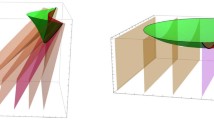Abstract
The global stability of the von Kármán boundary layer on the rotating disk is reviewed. For the genuine, radially inhomogeneous base flow, linearized numerical simulations indicate that convectively propagating forms of disturbance are predominant at all radii. The presence of absolute instability does not lead to the formation of any unstable linear global mode, even though the temporal growth rate of the absolute instability increases along the radial direction. Analogous behaviour can be found in the impulse solutions of a model amplitude equation, namely the linearized complex Ginzburg–Landau equation. These solutions show that, depending on the precise balance between spatial variations in the temporal growth rate and the corresponding shifts in the temporal frequency, globally stable behaviour can be obtained even in the presence of a strengthening absolute instability. The radial dependency of the absolute temporal frequency is sufficient to detune the disturbance oscillations at different radial positions, thus overcoming the radially increasing absolute growth, thereby giving rise to a stable global response. The origin of this form of behaviour can be traced to the fact that the cylindrical geometry of the rotating-disk flow dictates a choice of a globally valid time non-dimensionalization that, when properly employed, leads to a significant radial variation in the frequency for the absolute instability.
Similar content being viewed by others
References
von Kármán Th (1921) Über laminare und turbulente Reibung. Zeitschrift für angewandte Mathematik und Mechanik 1:233–252
Lingwood RJ (1995) Absolute instability of the boundary layer on a rotating-disk. J Fluid Mech 299:17–33
Briggs RJ (1964) Electron-Stream Interaction with Plasmas. MIT Press
Huerre P, Monkewitz PA (1990) Local and global in stabilities inspatially developing flows. Ann Rev Fluid Mech 22: 473–537
Huerre P (2000) Open shear flow instabilities. In: Batchelor GK, Moffat HK, Worster MG (eds) Perspectives in fluid Dynamics Springer, pp 159–229
Lingwood RJ (1997) On the effects of suction and injection on theabsolute instability of the rotating-disk boundary layer. Phys Fluids 9(5):1317–1328
Lingwood RJ (1996) An experimental study of absolute instability ofthe rotating-disc boundary-layer flow. J Fluid Mech 314:373–405
Davies C, Carpenter PW (2003) Global behaviour corresponding to the absolute instability of the rotating-disk boundary layer. J Fluid Mech 486:287–329
Davies C, Carpenter PW (2001) A novel velocity-vorticity formulation of the Navier–Stokes equations with applications to boundary layer disturbance evolution. J Comp. Phys 172:119–165
Othman H, Corke TC (2006) Experimental investigation of absolute instability of a rotating-disk boundary layer. J Fluid Mech 565:63–94
Pier B (2003) Finite-amplitude crossflow vortices, secondary instability and transition in the rotating-disk boundary layer. J Fluid Mech 487:315–343
Aranson IS, Kramer L (2002) The world of the complex Ginzburg–Landau equation. Rev Modern Phys 74:99–143
Gajjar JSB (1996) On the nonlinear evolution of a stationarycross-flow vortex in a fully three-dimensional boundary layer flow. In: Duck PW, Hall P (eds) Nonlinear instability and transition in three-dimensional boundary layers, IUTAM Symposium, Manchester, UK, 1995, Kluwer pp 317–327
Gajjar JSB, Arebi MA, Sibanda P (1996) Nonlinear development of cross-flow instabilities in compressible and incompressible boundary layer flows. AIAA Paper No. 96–2159
Hunt RE, Crighton DG (1991) Instability of flows in spatially developing media. Proc R Soc London A 435:109–128
Hunt RE (1995) Spatially developing flows with localized forcing, PhD Thesis, University of Cambridge
Soward AM (1977) On the finite amplitude thermal instability of a rapidly rotating fluid sphere. Geophys Astrophys Fluid Dyn 9:19–74
Soward AM (1992) Thin disc kinematic αω-dynamo models II. Short length scale modes. Geophys Astrophys Fluid Dyn 64: 201–225
Harris D, Bassom AP, Soward AM (2000) An inhomogeneous Landau equation with application to spherical Couette flow in the narrow gap limit. Physica D 137:260–276
Chomaz J-M, Huerre P, Redekopp LG (1991) A frequency selection criterion in spatially developing flows. Studies Appl Math 84:119–144
Monkewitz PA, Huerre P, Chomaz J-M (1993) Global linear stability analysis of weakly non-parallel shear flows. J Fluid Mech 251:1–20
Cossu C, Chomaz J-M (1997) Global measures of local convective instabilities. Phys Rev Lett 78:4387–4390
Davies C, Thomas C (2005) Global stability of the rotating-disk boundary layer and the effects of suction and injection. Bull Am Phys Soc 50(9):266
Author information
Authors and Affiliations
Corresponding author
Rights and permissions
About this article
Cite this article
Davies, C., Thomas, C. & Carpenter, P.W. Global stability of the rotating-disk boundary layer. J Eng Math 57, 219–236 (2007). https://doi.org/10.1007/s10665-006-9112-8
Received:
Accepted:
Published:
Issue Date:
DOI: https://doi.org/10.1007/s10665-006-9112-8



